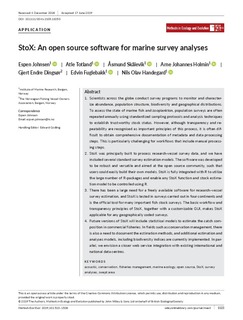| dc.description.abstract | Scientists across the globe conduct survey programs to monitor and characterize abundance, population structure, biodiversity and geographical distributions. To assess the state of marine fish and zooplankton, population surveys are often repeated annually using standardized sampling protocols and analysis techniques to establish trustworthy stock status. However, although transparency and repeatability are recognised as important principles of this process, it is often difficult to obtain comprehensive documentation of metadata and data processing steps. This is particularly challenging for workflows that include manual processing steps.
StoX was principally built to process research‐vessel survey data, and we have included several standard survey estimation models. The software was developed to be robust and versatile and aimed at the open source community, such that users could easily build their own models. StoX is fully integrated with R to utilize the large number of R‐packages and enable any StoX function and stock estimation model to be controlled using R.
There has been a large need for a freely available software for research–vessel survey estimation, and StoX is tested in surveys carried out in four continents and is the official tool for many important fish stock surveys. The basic workflow and transparency principles of StoX, together with a customizable GUI, makes StoX applicable for any geographically coded surveys.
Future versions of StoX will include statistical models to estimate the catch composition in commercial fisheries. In fields such as conservation management, there is also a need to document the estimation methods, and additional estimation and analyses models, including biodiversity indices are currently implemented. In parallel, we envision a closer web service integration with existing international and national data centres. | nb_NO |
